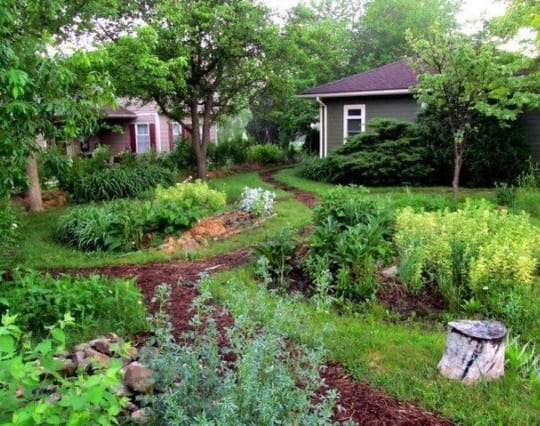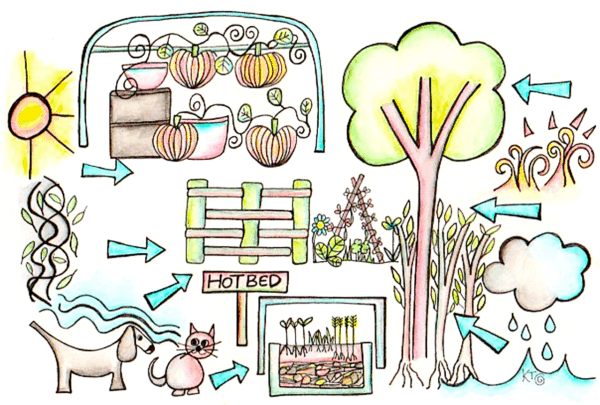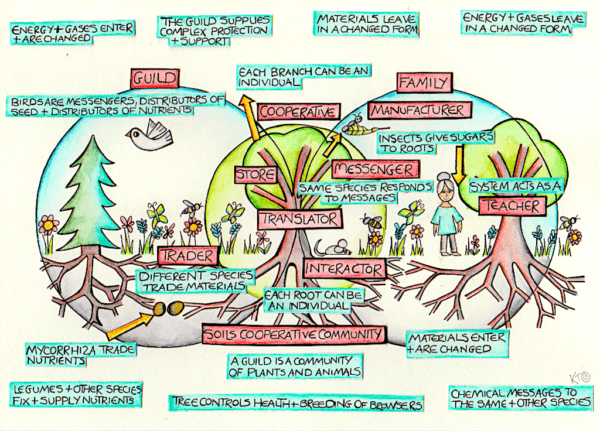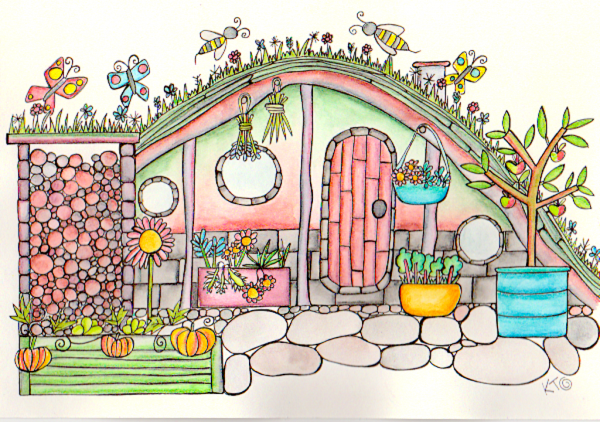
“Successful Permaculture earthworks begins with a desire to get the backbone of a design right. Following the design priorities of Water, Access, Structures (Yeoman’s Scale of Permanence), leads one onto the obvious placement for food productivity and leisure systems. The most difficult thing I have to face as a designer and earthworks installer is when I show up at a site and the client has already decided where everything will be going, pointing across the open space, house there, orchard there, chickens over there….Permaculture design is about just the opposite. First, design the water systems in the context of the land form, it then becomes obvious where everything else sits attached to that backbone.”
–Carolyn Gemmel
Changing landforms can vastly increase yields and improve the ecological integrity of a site. It can also destroy it. Design makes the difference.
Changing the land to meet our needs is a major part of permaculture. And especially in the beginning, when we are super excited to start changing the landscape, it can be tempting to dig big holes and build random hugelkultures, without being 100% clear about what happens next.
The primary purpose of earthworks is to keep water as high and as long in distance and time in the landscape as possible. Developing an awareness of how water responds to changes in the landscape, on any scale, from micro to macro, will help you understand how water infiltrates and travels through your earthworks project areas.
In high rainfall areas you may want to slow and divert the flow of water, whereas in drier climates storing and infusing your land with water may be the priority. Ultimately, the aim is to enhance or create the conditions needed so that plants we want to grow and animals we want to keep can flourish.

Due to the changing climate, and the increasing frequency of unstable and unusual weather patterns, it is good to understand the thinking behind different approaches and techniques, and to be aware of how and why people in different climates approach this topic. This, together with close observation of the landscape or cityscape around you, will mean that you are able to respond intelligently when unexpected weather affects your area.
In this article, we dive into an exploration of the principle of cyclic opportunity, and earthworks are one of the best ways to utilize that principle. For today, we’ll explore some of the most common types of earthworks, and identify which problems they might solve (or create!)

As with many new skills, one of the best ways to get your foot in the door with this body of knowledge is by becoming acquainted with the names of things. What follows is a list of the different types of earthworks commonly used in permaculture design, linked to useful articles on those techniques. The articles listed in this section were all written by members of the PWG faculty, and we’ve also linked additional resources at the bottom of this page.
Contours and Keylines
by Kelda Lorax
Working with contour/slope is like seeing the naked shape of the land and appreciating it, rather than ignoring, or worse, misusing it.
When we ignore the contours of the site:Gardens and other soil disturbances might be placed in ways that increase erosion and damage to the site.
We might place components of design in the wrong place, with decreased efficiencyWe might cause ourselves unnecessary work.

Swales and Berms
by Amy Stross
A swale is an earthwork technique that takes advantage of the land’s contour to encourage infiltration and increase the soil’s storage capacity. For this reason, swales can be an important tool for passive irrigation, as well as reducing erosion and stormwater runoff.
Swales not only catch water, but also soil, seeds, and organic matter, keeping them onsite rather than washing them away. Swales work best on land that is gently to moderately sloped, but they can also be useful on flat land, as even flat land must drain somewhere.

Hugelkultur
by Diana Sette
Imagine the forest floor of an old growth forest. Layers of humus, maybe little slopes from tree roots, or moss covered, decomposing fallen logs, cover the landscape. Herbaceous plants unfurl in the crevices and atop mounds. Self mulched surfaces produce rich, organic matter from which mushrooms and shrubs spring. Decaying leaves are food for worms, insects, and other arthropods.
There is no need for a hose to water, and if it downpours there, it is unlikely to flood, as the carbon-rich soils have significant layers of organic matter, and have an extensive water holding capacity.

Terraces
Terraces are an excellent way to harness the potential of a sloped garden and make it much easier to maintain.
Humans have been building terraced gardens since the dawn of agriculture. The basic technique is easy enough, once you’ve got your slope and contours mapped.
If this is a technique that makes sense for your site, start with this article, also by Amy Stross.

Reasons to Use Earthworks in a Permaculture Design
Here are just a few of the reasons you might include these or other types of earthworks in your design:
- Water management. Creating channels for water enables natural irrigation of crops.
- Directing flow of human and animal traffic. Berms, swales, and rockwork can create lanes, gateways and even facilitate natural weaning of lambs via traditional lamb creeps.
- Creating edge zones. The edge between one microclimate and another (such as between a pond and the shore, or between a swale, berm, and the flat zone,) is an area favoured by many plants and animals who like having the best of both worlds, or even all three worlds: the water world, the land and the air.Processing debris, such as with berms and hugelkultur.
- No waste! Debris can be used to create super fertile beds and great habitat, increasing biodiversity and encouraging natural balance.
- Creating habitat. Water attracts wildlife! Adding a pond multiplies the numbers and types of wildlife in, on and around the edges. Berms and hugelkultures also create habitat for small mammals, beneficial reptiles and insects.
- Preventing erosion. Controlling water flow can increase the natural storage of water in the land. It also slows the water, which allows it to drop sediment rather than washing it away.
- Establishing boundaries. Long, curving berms and hedgerows are much more attractive and welcoming than fences. In many places hedges are traditionally planted on top of earth banks, or a mix of stone and turf, providing an instant boundary and shelter, long before the hedge matures.
And so much more! What reasons can you think of for using earthworks in your own garden?
A few words of warning!
No matter what, your earthworks designs should always be site specific. Some earthwork strategies will be to retain water and help it infiltrate back into the soil and aquifer, and some strategies will be dealing with excessive water that needs to be moved into other locations on the site.
Planning a series of terraces on a sunny slope can be a great use of space, but can be disastrous if erosion concerns are not addressed first and water flow down the hill is not considered. By the same token, a misapplied hugelkultur bed can lead to a festering, anaerobic overgrowth of bacteria in which nothing else grows.
The risks of doing permanent damage to your site with ill-conceived earthworks cannot be overstated. Keep this admonition in mind as you work to redirect water and resources around your site.
Consider these to be strict guidelines for earthworks in a permaculture design, and do not do any sort of major earthmoving (or even basic shovel work) when any of the following conditions apply:
- The soil is too wet.
- The soil is too dry.
- You don’t know enough about the soil.
- You haven’t observed the site for long enough.
- You haven’t talked to the neighbors up and down slope.
- You haven’t measured the slope and contours of the site.
- Your earthworks plan is not tied into a whole-system design.
- You don’t have a plan for where newly harnessed water will drain.
- You don’t have a plan for where to take any soil or debris you will dig up.
- You haven’t spoken at length with whoever is driving the equipment and made sure they 100% understand the design.
- You haven’t clearly marked the boundaries and parameters of the project so that workers can see where to stop, turn, and drop material.
- You really don’t need to dig anything up because a no-till approach makes more sense for the site.

Earthworks in permaculture design: a farm-scale example
Here’s a fun video demonstrating the keylines and swales project at Hawk’s Journey farm:
Want to learn more about this and other topics related to permaculture, sustainability, and whole-systems design? We offer a range of FREE (donations optional) online courses!
Relevant Links and Resources
What is Keyline Design?
Here’s an excellent article with tons of great examples of how keyline design can be used to improve big pieces of land.

Turn your lawn into berms that create contour on an otherwise flat site. You don’t have to have swales to make use of berms, and sod, ripped out, turned over and piled up, does the trick. Read a bit more about that in this article by Heather Jo Flores, about turning your lawn into a garden.

Front-yard rain garden and berm.Here’s an article from Midwest permaculture, about a suburban yard that was completely transformed!

Subak, the traditional Balinese water and land management practice involves extensive earthworks which connect democratically managed rice paddy systems into a larger cultural network connected with the regional water temples.




